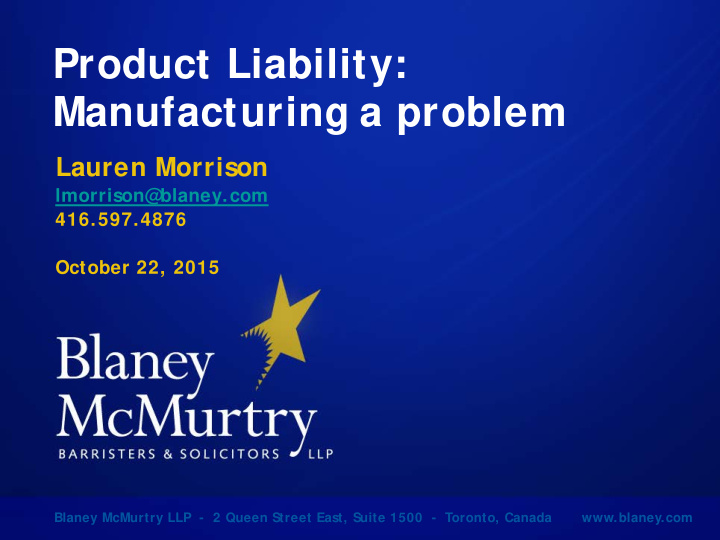



Product Liability: Manufacturing a problem Lauren Morrison lmorrison@blaney.com 416.597.4876 October 22, 2015 Blaney McMurtry LLP - 2 Queen Street East, Suite 1500 - Toronto, Canada www.blaney.com
What is product liability? Product liability is the area of law under which a manufacturer, or another party in the manufacturing or distribution chain, is held responsible for a defective product that has caused damage
Overview Types of defects How to prove a defect S ources of liability Potential parties – who may be liable Defences available Types of damages Things to consider when investigating a product liability claim
Famous cases: Donoghue v S t evenson, 1932 snail found in bot t le of ginger beer Buckley v Mot t , 1919 powdered glass in chocolat e candy bar Cohen v Coca-Cola, 1967 exploding glass Coke bot t le … and
McDonald’s coffee case Liebeck v McDonald’ s , 1994 79 year old woman spilled coffee on her lap Coffee was too hot Originally awarded $2.7 million, adj usted to $600,000 on appeal
What is a defect? Three Types of Defects Manufacturing defects Design defects Marketing defects/ Failure to warn defects
Warning Labels
How do you prove a defect? Onus on the plaintiff Factual evidence Expert evidence
Other elements to consider Time of testing Recalls Misuse of product Inherent risks
Sources of liability 1. Tort A. Does the manufacturer owe a duty of care? Neighbour principle “ Persons who are so closely and directly affected by my act that I thought reasonably to have them in contemplation as being so affected when I am directing my mind to the acts or omissions which are called into question” t evenson, 1932 AC 562 Donoghue v S B. Did the manufacturer breach the standard of care? C. Are there damages? D. Did the manufacturer’ s breach cause the damages suffered?
Sources of liability 2. Contract Product sale agreements Consider who is a party to the contract Warranties or representations 3. S tatute S ale of Goods Act Canada Consumer Product S A ) afet y Act (CCPS Convent ion on Cont ract s for t he Int ernat ional S ale of Goods Act ( CIS G )
Who can be liable? Importers, Distributors, Retailers & Manufacturers Wholesalers Installers & Users Repairers Inspectors & Occupiers Certifiers
Where: Jurisdiction Where can the plaintiff sue? What law applies to the plaintiff’ s claim? Foreign j udgments
What are the damages? Non-pecuniary loss Pecuniary loss Punitive damages Pure economic loss “ People should not look to tort law to negotiate a better bargain for themselves.” - Justice Perrell, Arora v Whirlpool LP , 2012 ONS C 4642
Defences Factual dispute Voluntary assumption of risk Contributory negligence Limitation period
What do you need to consider when investigating a claim? Defective product Design process Manufacturing process Product testing / Quality control Oversight during production Component materials – “ material fade” Warnings Placement of label / Visibility Diagram/ Image, Words or a combination of both Translation
What do you need to consider when investigating a claim? Other parties in the distribution chain Contracts Packaging S hipping records Marketing messages Return of goods procedure Discovery of claim Jurisdiction issues
QUES TIONS ?
Recommend
More recommend